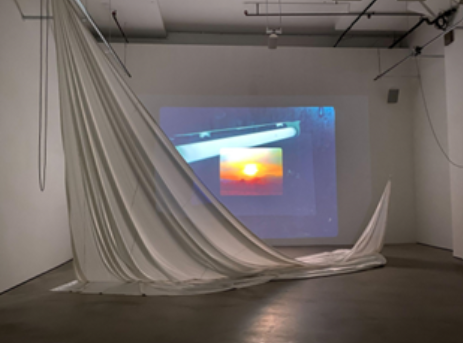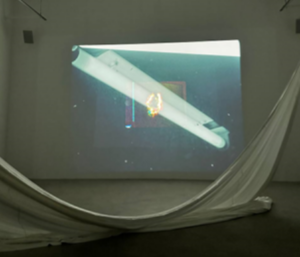Reviewed by Goh Cheng Hao
With the hyper-action and sensationalism of contemporary cinema, what opportunities does the approach of slow cinema present?
During Singapore Art Week, an array of nine of Apichatpong Weerasethakul’s short films were screened at the S.E.A. Focus Fringe Film Programme: OFF Focus 2024, curated from his oeuvre of around forty-or-so of them. These included (in sequence) Sakda (Rousseau), Monsoon, M Hotel, Ghost of Asia, Luminous People, Emerald, Footprints, Vapour, and A Letter to Uncle Boonmee.
Known for his 2010 film Uncle Boonmee Who Can Recall His Past Lives, Apichatpong is regarded as one of the key players in the slow cinema genre, and this collection of short films echoes those same stylistics of stillness. The films were hypnotic and contemplative – and if I’m being honest, contemplative stands as a euphemism for boring here – with many overlapping themes of memory, decay, the mundane, and even the act of sleeping.

Film still from Luminous People
With a total runtime of slightly less than two hours, the lack of a consistent narrative driving force combined with many inactive long takes and scenes made the collection of short films feel cohesive, if not equally meandering. Despite title cards and credit scenes demarcating the boundaries of each film, the stagnation still pervaded the collection, the films almost melding together like a dreamlike sequence.
While approaching arthouse or slow cinema may be intimidating in their unintelligibility or pretentiousness, I think that there is an artfulness in what Apichatpong does here in his films. Essentially, he presents a non-story, taking away all the foundations of cinema: plot, suspense, conflict, climax, action, even aesthetics, and the viewer sits in a constant state of anticipation for some narrative payoff or resolution to occur, only to be met with disappointment when the credits roll.
In a post-screening Q&A, Apichatpong talks precisely about this absence of story in his films, remarking how filmmaking for him was “less about story…for me, I’m pretty interested in the non-logic of it…”, and how he instead tries to capture something not necessarily physical or sensual, “something out there that you don’t know…the idea of the ghost or mystery”.
What is interesting is how Apichatpong transfers the onus of storytelling onto the viewer: he subverts how viewers are usually rendered passive, passively absorbing the narrative at face value.
As a viewer, you quickly realise the futility of scrutinising every scene for any hint of story. Instead you begin to think about how the decontextualised scenes presented relate to a bigger existential or philosophical picture, or perhaps how they relate to your own experiences. The ambiguity of the film becomes a canvas to impose your own understanding and stories onto it, and it becomes a sort of dialogical, collaborative project between you and Apichatpong. In this way, the film becomes concerned with the possibility for resonance rather than for a relatability in images.
What I also appreciated was how conventions of looking at film were upturned: the focus becomes less about the message of the film, but more about the experience of it. You are incentivised to look at the film more formalistically, to be more conscious of the atmosphere and mood, the framing and composition, aspects of film typically overshadowed by dramatic action and narrative.
Ultimately, while slow cinema purports to provide a respite from the over-saturation of action and dramatics in film, I felt these insights came a bit belated. If anything, the films were more retrospective than introspective, in the way that they only come after you sit and mull over the film a few days later, but perhaps there is an unavoidable learning curve when trying to detach from the genres of film we are used to. At an immediate and surface level, Apichatpong’s films may hence feel inaccessible to a lot of viewers.
On a related note, Apichatpong also had a video installation piece called A Conversation with the Sun at the S.E.A. Focus exhibition, and it was a film of AI-sequenced clips from Apichatpong’s self-documented footage which was projected onto a piece of white fabric. Conversations between the artist and AI-generated avatars of individuals (Dali, Jiddu Krishnamurti, the sun) were also projected from speakers.

Photograph of A Conversation with the Sun
The experience of the film/video installation was a far cry from watching his short films in OFF Focus, and the stark difference in setting really made me think about its presentation, especially when such films tread the intersection between film and video art. How successfully are the sentiments of slow cinema translated when viewing such films/video art in a different environment?
A Conversation was a short-lived encounter for many viewers, compared to the experience of watching Apichatpong’s short films in a cinema, which demands attention (or inattention) and incentivises viewers to finish the film in full (having spent money on a ticket). Unlike other video art exhibitions that went on during Singapore Art Week (47 Days, Sound-less by Nguyễn Trinh Thi, Time and the Tiger by Ho Tzu Nyen), there was a lack of seating and thus not much incentive to stay and watch the whole film in its entirety.
In this way, only glimpses of the film are seen by viewers, which initially seems antithetical to the ethos of slow cinema of fostering introspection with its long takes and anticlimax. However, the work takes on a different tenor, one that invites viewers to glimpse fleeting moments on the off chance that it might resonate with them.
While such a presentation may seem like a disservice to the elements of slow cinema, perhaps these chance encounters are equally as poetic, and perhaps a more forgiving mode compared to the more heavy-handed and imposing experience that is the cinema (as in OFF Focus).

Photograph of A Conversation with the Sun
While I was initially sceptical about the slowness of Apichatpong’s short films, I found that I eventually gained an appreciation for them. My takeaway is that the emotional or intellectual fulfilment from a film isn’t immediate, and films can take a while to grow on you. Boring isn’t necessarily a negative term – a film can be boring and yet still be interesting – and sometimes you have to work to find something to resonate with within a film.
Click Here For More Film Reviews
Do you love writing? Send us a film review and we will feature it on our website. Any film that people can see in the theater or online. Email to: media@scape.sg
This review is also published on Singapore Film Society as part of *SCAPE’s Film Critics Lab: A Writing Mentorship Programme.
